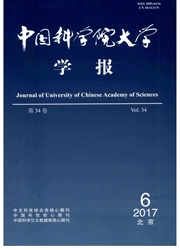

 中文摘要:
中文摘要:
基于气溶胶云下清除过程中起决定作用的雨滴与气溶胶碰并机制理论,详细探讨碰并系数与雨滴和气溶胶直径的关系,并针对雷暴天与非雷暴天,从理论上对比这2种天气条件下雨滴碰并不同尺度气溶胶的清除系数.利用2011年6—8月黄山光明顶与汤口寨西气溶胶浓度观测数据,对比黄山地区雷暴与非雷暴天气条件下的清除系数的实测值与理论值,并讨论黄山地区清除系数与雨强的关系.结果表明,在气溶胶粒径为0.01~0.1μm时,清除系数实测值与理论值变化趋势一致,实测值高出理论值5—6倍;在0.1~1μm粒径段,清除系数的实测值雷暴天高于非雷暴天;且清除系数与雨强呈正指数关系,相关系数为0.81.
 英文摘要:
英文摘要:
As the collision theory for raindrop and aerosol particle is important in below-cloud scavenging, collision efficiency as a function of raindrop diameter (Dp) and aerosol diameter ( dp ) is discussed. The scavenging coefficient (SC) under thundercloud is 5 to 6 times higher than those under non-thundercloud when dp is less than 1 μm. Field measurements of aerosol number concentration at bottom and top of Huangshan mountain from June to August of 2011 were used to analyze the variation characteristics of observed and theoretical SCs. The results show that observed SC variation for ultrafine-sized particle is in reasonable agreement with the theoretical one, and the observed SC is 5 to 6 times higher than the theoretical SC. Submicron-sized particle SC is higher under thundercloud than that under non thundercloud. Based on the observations, exponential relationship between the hour-averaged SC and rainfall intensity is derived, in which the correlation coefficient is 0.81.
 同期刊论文项目
同期刊论文项目
 同项目期刊论文
同项目期刊论文
 Altitudinal effect to the size distribution of water soluble inorganic ions in PM at Huangshan, Chin
Altitudinal effect to the size distribution of water soluble inorganic ions in PM at Huangshan, Chin The effects of deep convection on the concentration and size distribution of aerosol particles withi
The effects of deep convection on the concentration and size distribution of aerosol particles withi The characteristics of atmospheric ice nuclei measured at the top of Huangshan (the Yellow Mountains
The characteristics of atmospheric ice nuclei measured at the top of Huangshan (the Yellow Mountains Size distributions of aerosol and water-soluble ions in Nanjing during a crop residual burning event
Size distributions of aerosol and water-soluble ions in Nanjing during a crop residual burning event Impacts of topography and land cover change on thunderstorm over the Huangshan (Yellow Mountain) are
Impacts of topography and land cover change on thunderstorm over the Huangshan (Yellow Mountain) are The Characteristics of Atmospheric Ice Nuclei Measured at Different Altitudes in the Huangshan Mount
The Characteristics of Atmospheric Ice Nuclei Measured at Different Altitudes in the Huangshan Mount Size-resolved chemical composition of atmospheric particles during a straw burning period at Mt. Hua
Size-resolved chemical composition of atmospheric particles during a straw burning period at Mt. Hua The impacts of fireworks burning at Chinese Spring Festival on air quality and human health: insight
The impacts of fireworks burning at Chinese Spring Festival on air quality and human health: insight The characteristics of atmospheric ice nuclei measured at different altitudes of Mts. Huangshan in s
The characteristics of atmospheric ice nuclei measured at different altitudes of Mts. Huangshan in s 期刊信息
期刊信息
